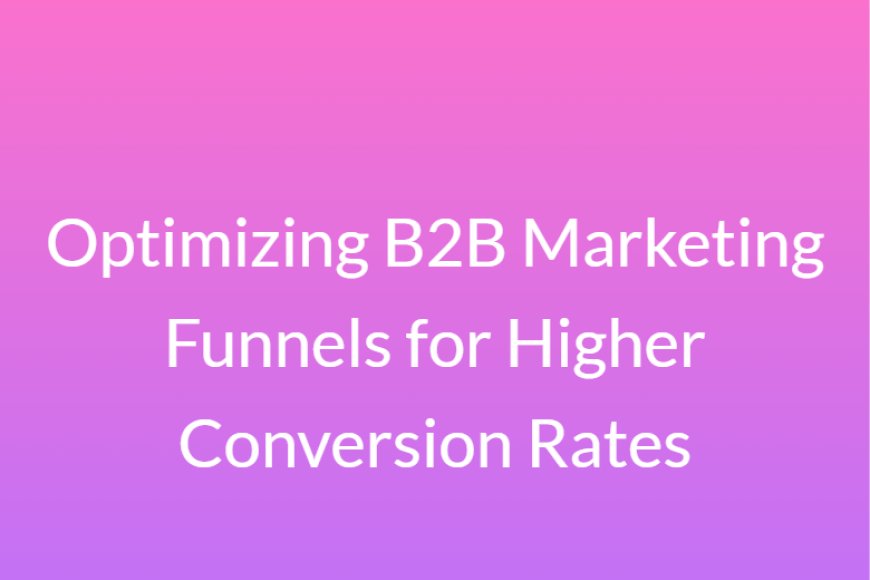Optimizing B2B Marketing Funnels for Higher Conversion Rates
The digital transformation of B2B industries has redefined how businesses attract, nurture, and convert prospects.

Central to this evolution is the use of B2B Marketing Funnels strategic frameworks that guide potential buyers through a series of decision-making stages. Optimizing these funnels is no longer optional; its a vital part of improving lead quality, accelerating the sales cycle, and boosting marketing ROI.
In B2B environments, where purchases are large-scale and decision-making is complex, buyers move more cautiously than their B2C counterparts. Thats why every phase of B2B marketing funnels must be deliberately crafted to engage with buyers, address objections, and provide a personalized journey that supports conversion readiness.
The Conversion Gap in B2B Marketing Funnels
Many B2B companies struggle to convert marketing-qualified leads (MQLs) into actual customers. This gap often exists due to poorly aligned funnel stages, a lack of relevant content, or insufficient follow-up strategies. If the funnel is not optimized, leads will leak out, become disengaged, or fall into sales limbo.
The first step in closing this gap is identifying where the drop-offs happen. Are leads failing to move from awareness to interest? Are they ghosting after the consideration phase? Tracking user behaviors and engagement metrics across each stage allows marketers to make data-driven improvements to their B2B marketing funnels.
Designing Intent-Focused Top-of-Funnel Strategies
The top of the funnel is often the most misunderstood part of B2B marketing funnels. Many marketers focus too heavily on driving traffic without considering the quality or intent of those visitors. An optimized top-of-funnel strategy should prioritize not just reach but relevance.
Creating educational blog posts, publishing market insights, and launching SEO-targeted content help attract informed prospects. However, it's critical to speak directly to the unique pain points of your ideal buyer personas. Using intent data to identify topics that resonate can make your content strategy more effective.
Lead magnets, such as industry guides or templates, can further qualify traffic and generate leads. The focus should always be on providing value thats aligned with the buyers current mindsetnot pushing your product too early.
Middle-of-Funnel Tactics That Nurture Without Pressure
Once a lead has shown interest, the middle of the funnel becomes the stage for relationship-building. B2B marketing funnels must guide leads without overwhelming them. Overcommunication or misaligned messaging at this stage can cause drop-off or delay decision-making.
The best MOFU tactics include interactive content, webinars, gated assets, personalized email sequences, and account-based retargeting. These efforts should educate the lead on potential solutions while introducing your products capabilities naturally.
Lead scoring plays a vital role here. By assigning point values based on actions like webinar attendance, email opens, or content downloads, you can determine when a lead is ready to advance. Leads that havent met your criteria can remain in nurture streams until theyre more engaged.
Accelerating Action at the Bottom of the Funnel
The final stage of B2B marketing funnels the decision phase is where many leads stall. Decision-makers may be comparing vendors, seeking internal buy-in, or hesitating due to budget concerns. Your job as a marketer is to reduce friction and make conversion feel like a confident next step.
Case studies, ROI calculators, and tailored demos are powerful tools in this phase. You should also consider one-on-one consultations, free trials, and personalized video walkthroughs that show how your product solves the buyers specific challenges.
Strong CTAs and short, clear decision paths are essential. If your landing pages are cluttered or your pricing is hard to find, buyers may become frustrated. Every step should reduce uncertainty and increase clarity.
Using Data and Analytics to Identify Funnel Bottlenecks
An optimized funnel relies on constant measurement. Metrics like lead-to-opportunity ratio, time in funnel, drop-off rate, and channel conversion rate reveal which stages are performing and which need improvement. For example, if many leads engage at the top but few progress to the middle, you may need stronger middle-funnel assets or better lead scoring.
Heatmaps, A/B testing tools, and journey mapping platforms can help you see exactly how users interact with your funnel. This enables marketers to test content placement, CTA buttons, and form fields to improve conversion efficiency.
Beyond performance, qualitative data such as buyer feedback and sales team input can uncover what prospects are thinking at each stage. B2B marketing funnels should be treated as living systemsregularly reviewed, adjusted, and optimized.
Integrating Personalization at Every Stage
One of the most effective ways to optimize B2B marketing funnels is through personalization. Generic messaging no longer resonates with todays buyers. Instead, buyers expect experiences that are tailored to their industry, role, stage in the journey, and specific challenges.
Personalization starts with segmentation. By dividing your audience by firmographic data, buying intent, or behavioral signals, you can deliver more targeted messages. Examples include using dynamic content on landing pages, customized email nurture tracks, or account-specific retargeting ads.
With the help of AI and marketing automation tools, personalization at scale is now possible. Whether its recommending relevant content or adjusting CTA language based on visitor behavior, small tweaks can lead to big improvements in funnel performance.
Aligning Marketing and Sales for Funnel Efficiency
Misalignment between sales and marketing teams can sabotage even the best-designed B2B marketing funnels. Leads may be handed off too soon, followed up too late, or misunderstood altogether. When both teams work in silos, it creates a disjointed experience for the buyer.
Sales and marketing should co-own funnel success by agreeing on lead definitions, setting SLAs, and sharing insights regularly. Joint funnel reviews allow both teams to spot gaps and brainstorm improvements. For example, if MQLs arent converting into SQLs, both teams should analyze qualification criteria and lead nurturing efforts.
When marketing and sales operate as a single unit, buyers receive a seamless journey from awareness to close. This leads to higher win rates, shorter cycles, and stronger revenue growth.
The Role of Marketing Automation in Funnel Optimization
Marketing automation platforms are essential for scaling and streamlining B2B marketing funnels. They allow marketers to deliver timely, personalized content, trigger workflows based on behavior, and monitor lead activity across all digital channels.
By integrating automation into your funnel strategy, you can nurture leads more efficiently, reduce manual effort, and maintain consistent messaging. Automation also supports lead scoring and segmentation, ensuring that only qualified leads are passed to sales.
In addition, these platforms offer real-time reporting, so you can quickly spot changes in funnel performance. Whether its HubSpot, Marketo, Pardot, or another platform, the right tool will help marketers manage complexity with ease.
Using Funnel Segmentation to Drive Deeper Engagement
Not all buyers follow the same path, and your B2B marketing funnels should reflect that reality. Funnel segmentation allows you to adapt your messaging and offers based on where different leads are in the process or what product theyre interested in.
Segmenting by buyer persona ensures that each group receives content that speaks directly to their role and responsibilities. A CTO will care about technical specs and integration, while a CFO will want to see ROI and budget efficiency.
Segmenting by funnel behavior such as bounce rates or repeat visits can help tailor remarketing campaigns. By using segmentation wisely, you can create funnel experiences that feel more personal and less mechanical.
Refining Content Based on Funnel Feedback
Content is the fuel that powers B2B marketing funnels. But even great content needs ongoing refinement to stay effective. Reviewing performance metrics helps identify which pieces are moving leads forward and which are stalling progress.
Its also important to match the format of content with buyer preferences. Some audiences prefer video explainers, while others want detailed whitepapers or live demos. Offering a range of formats gives buyers more control and increases engagement.
Use feedback from sales teams and direct customer input to improve content relevancy. When prospects feel understood, they are more likely to trust your solution and move forward in the funnel.
Read the Full Blog Now @ https://acceligize.com/featured-blogs/b2b-marketing-funnels-a-complete-guide-for-marketers/
About Us
Acceligize is a global leader in B2B demand generation and sales enablement, specializing in connecting businesses with highly targeted, ready-to-engage prospects. Through innovative digital marketing strategies, buyer intent data, and multi-touch campaigns, Acceligize empowers sales and marketing teams to drive growth, generate qualified leads, and achieve faster revenue outcomes. With a focus on accuracy, engagement, and scalability, Acceligize delivers real, measurable results to enterprises across industries.































